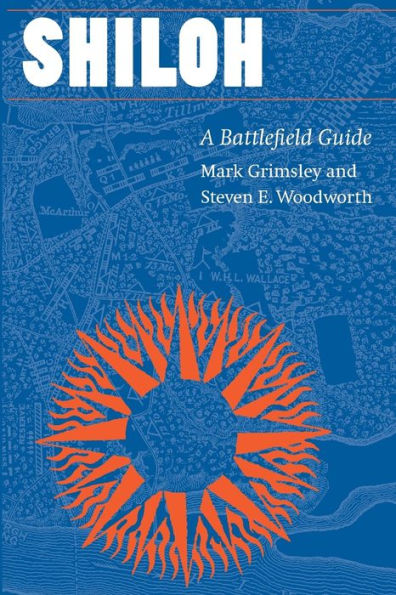Shiloh: A Battlefield Guide
Peabody's Battle Line, McCuller's Field, Stuart's Defense, the Peach Orchard, and Hell's Hollow-these monuments mark some of the critical moments in the battle of Shiloh but offer the visitor only the most meager sense of what happened on the banks of the Tennessee in April 1862. This battlefield guide breathes life into Civil War history, giving readers a clear picture of the setting at the time of engagement, who was where, and when and how the battle progressed.
Designed to lead the user on a one-day tour of one of the most important battlefields of the war, the guide provides precise directions to all the key locations in a manner reflecting how the battle itself unfolded. A wealth of maps, vivid descriptions, and careful but accessible analysis makes plain the sweep of events and the geography of the battlefield, enhancing the experience of Shiloh for the serious student, the casual visitor, and the armchair tourist alike.
Mark Grimsley is a professor of history at Ohio State University. He is the author of And Keep Moving On: The Virginia Campaign, May-June, 1864, and the coeditor of Civilians in the Path of War, both published by the University of Nebraska Press. Steven E. Woodworth is a professor of history at Texas Christian University. He is the author of Chickamauga: A Battlefield Guide and Six Armies in Tennessee: The Chickamauga and Chattanooga Campaigns, both published by the University of Nebraska Press.
1102799236
Designed to lead the user on a one-day tour of one of the most important battlefields of the war, the guide provides precise directions to all the key locations in a manner reflecting how the battle itself unfolded. A wealth of maps, vivid descriptions, and careful but accessible analysis makes plain the sweep of events and the geography of the battlefield, enhancing the experience of Shiloh for the serious student, the casual visitor, and the armchair tourist alike.
Mark Grimsley is a professor of history at Ohio State University. He is the author of And Keep Moving On: The Virginia Campaign, May-June, 1864, and the coeditor of Civilians in the Path of War, both published by the University of Nebraska Press. Steven E. Woodworth is a professor of history at Texas Christian University. He is the author of Chickamauga: A Battlefield Guide and Six Armies in Tennessee: The Chickamauga and Chattanooga Campaigns, both published by the University of Nebraska Press.
Shiloh: A Battlefield Guide
Peabody's Battle Line, McCuller's Field, Stuart's Defense, the Peach Orchard, and Hell's Hollow-these monuments mark some of the critical moments in the battle of Shiloh but offer the visitor only the most meager sense of what happened on the banks of the Tennessee in April 1862. This battlefield guide breathes life into Civil War history, giving readers a clear picture of the setting at the time of engagement, who was where, and when and how the battle progressed.
Designed to lead the user on a one-day tour of one of the most important battlefields of the war, the guide provides precise directions to all the key locations in a manner reflecting how the battle itself unfolded. A wealth of maps, vivid descriptions, and careful but accessible analysis makes plain the sweep of events and the geography of the battlefield, enhancing the experience of Shiloh for the serious student, the casual visitor, and the armchair tourist alike.
Mark Grimsley is a professor of history at Ohio State University. He is the author of And Keep Moving On: The Virginia Campaign, May-June, 1864, and the coeditor of Civilians in the Path of War, both published by the University of Nebraska Press. Steven E. Woodworth is a professor of history at Texas Christian University. He is the author of Chickamauga: A Battlefield Guide and Six Armies in Tennessee: The Chickamauga and Chattanooga Campaigns, both published by the University of Nebraska Press.
Designed to lead the user on a one-day tour of one of the most important battlefields of the war, the guide provides precise directions to all the key locations in a manner reflecting how the battle itself unfolded. A wealth of maps, vivid descriptions, and careful but accessible analysis makes plain the sweep of events and the geography of the battlefield, enhancing the experience of Shiloh for the serious student, the casual visitor, and the armchair tourist alike.
Mark Grimsley is a professor of history at Ohio State University. He is the author of And Keep Moving On: The Virginia Campaign, May-June, 1864, and the coeditor of Civilians in the Path of War, both published by the University of Nebraska Press. Steven E. Woodworth is a professor of history at Texas Christian University. He is the author of Chickamauga: A Battlefield Guide and Six Armies in Tennessee: The Chickamauga and Chattanooga Campaigns, both published by the University of Nebraska Press.
19.95
In Stock
5
1

Shiloh: A Battlefield Guide
176
Shiloh: A Battlefield Guide
176Paperback(First Edition)
$19.95
19.95
In Stock

Product Details
| ISBN-13: | 9780803271005 |
|---|---|
| Publisher: | Bison Original |
| Publication date: | 03/01/2006 |
| Series: | This Hallowed Ground: Guides to Civil War Battlefields |
| Edition description: | First Edition |
| Pages: | 176 |
| Product dimensions: | 5.50(w) x 8.50(h) x 9.00(d) |
About the Author
From the B&N Reads Blog
